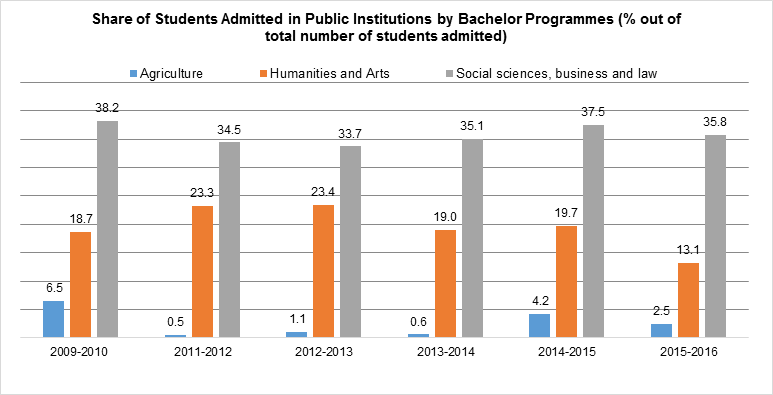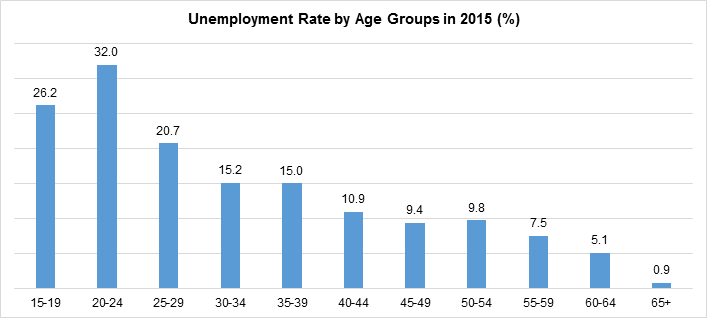 15
November
2021
15
November
2021
ISET Economist Blog
 Saturday,
18
March,
2017
Saturday,
18
March,
2017

 Saturday,
18
March,
2017
Saturday,
18
March,
2017
In developed countries like Korea and Australia, employment in the agricultural sector is gaining more and more popularity, however, moving back to the countryside in developing nations remains associated with poverty, inefficiency, and lack of progress.
In Georgia, the majority of the population is employed in agriculture, but this employment in most cases is a result of adverse circumstances, rather than a voluntary career choice. According to statistics, agriculture is not attractive to young Georgians, and the number of students interested in the field is extremely low compared to other specialties.

The social sciences, business, and law, together with humanities and arts, are the top career choices for Georgian students, whereas demand for agricultural education is much lower. This trend continues in spite of the government’s efforts to make this profession more attractive by offering agricultural courses for free.
At the same time, unemployment rates among youth are the highest compared to the other age categories, signaling that the career choices of Georgian students do not always lead to expected outcomes, such as employment and high earnings.

In spite of high unemployment among youth, agriculture as an employment opportunity is still unpopular.
Various studies have shown that the main challenges of youth entering the agro sector include lack of education and vocational training, limited access to finance, negative perception of agriculture, and underdeveloped rural areas.
Lack of education and vocational training is reflected in the fact that very few universities offer agriculture-related courses to their students. Regional branches are doing better in this regard, but leading universities in Tbilisi either do not have agricultural courses in the curriculum or offer very few.
Limited access to finance is yet another challenge faced by young people willing to engage in agriculture. Most of them do not have savings due to their young age and struggle to get loans from banks. As a result of this, their opportunities for self-development in agriculture are rather limited.
A negative perception of agriculture is another contributor to the low involvement of youth in agriculture. Lawyers, doctors, and economists were always more respected than farmers in Georgian society; in fact, almost any other profession is regarded as better than agriculture. There are very few people who consider farming as a viable business opportunity. For the majority of people, farming is still associated with producing food at meager subsistence-level rates.
Underdeveloped rural areas reduce young people’s willingness to stay in their villages and devote themselves to farming. When youth can’t find viable jobs in their communities, they begin to migrate from rural areas in bigger cities or different countries in search of opportunities, where they face an uncertain future.
These challenges prevent many young Georgians from entering agriculture. They restrain many, but not all…
Agripreneurs are defined as entrepreneurs who turn their farms into businesses. Although most of them are young, business-oriented farmers, there are many middle-age agripreneurs not involved in farming, but contributing to the creation of higher value-added in the value chain through processing or packaging of agricultural products.
One such example of a Georgian agripreneur is Toma Khalvashi, the 27-year-old founder of Agro Consulting Centre (ACC), located in the Adjara region of Georgia. ACC is represented by a team of eight people, with the oldest member being 30 years old. The company has quite a diversified portfolio and offers farmers a one-year consulting package which includes online and phone consultations and two visits to the farm. It also offers laboratory analysis of soil, a wide range of chemicals and seedlings, development of agro calendars, information brochures, and trainings. The most important component of the business includes the purchase of agricultural produce from contracted farmers, and exports of those products abroad.
The Center has a nursery, an agro shop, and a laboratory. It is working on the development of an online catalogue in order to allow farmers to order agricultural inputs online, and there is a delivery service available as well. Such a diversified portfolio serves the main aim of the Center - serving farmers through the “one window” principle.
The principle seems to be working in practice, because currently, the total number of ACC’s beneficiaries totals 1,150 farmers, with up to 1,000 farmers having purchased the one-year consultation package for 350 GEL. In order to reach this number of customers, the Center started with free consultations, training sessions, and lectures. After positioning itself as a reputable consultation service, the center’s representatives developed the service package and offered it to farmers whose interest in the company is constantly growing.
Toma Khalvashi’s case, though successful, is rather rare.
The first step in this direction might be adding agriculture to the curriculum of students at high schools. Kenya provides a good example of how this recommendation can work in practice. Farm Africa’s Youth Empowerment in Sustainable Agriculture (YESA) project allowed African pupils to get more information about growing high-value crops, as well as pricing and marketing them for global markets. Adding agriculture to the curriculum in Georgia will also contribute to improving the image of agriculture so that youth will see it as a viable employment opportunity.
Another important point is rural development - a very complex issue which, by definition, refers to the process of improving the quality of life and economic well-being of people living in relatively isolated and sparsely populated areas. The government of Georgia has adopted the first National Strategy for Rural Development this year and presented it publicly just a couple of days ago. Hopefully, this strategy reaches its goal and makes rural areas better places for youth (and not only) to live and work.
Other ways of increasing youth participation in agriculture could include creating an enabling business environment for agribusinesses (e.g. tax incentives), building youth’s skills in information and communication technologies (ICT), offering start-up aid for young farmers as in the Common Agricultural Policy (CAP), and so on.
All these activities should lead to an infusion of the energy and talents of young Georgians into agriculture and bring a big boost to agricultural growth and food security.
* * *
The article was produced with the assistance of the European Union through its European Neighbourhood Programme for Agriculture and Rural Development, Austrian Development Cooperation, CARE Austria, or CARE International in the Caucasus. The contents are the sole responsibility of the authors and can in no way be taken to reflect the views of the European Union, Austrian Development Cooperation, CARE Austria, or CARE International in the Caucasus.





